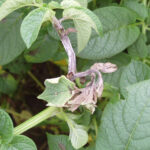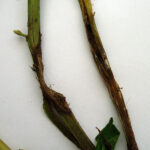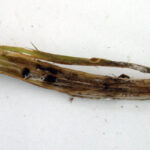Polish name: Zgnilizna twardzikowa
English name: White Mould / Sclerotina Stalk Rot
Kod EPPO: SCLESC
Perpetrator of the disease:
- Fungus Sclerotinia sclerotiorum
Gallery

White Mold. Initial symptoms of the disease.
(Photo by J. Osowski)
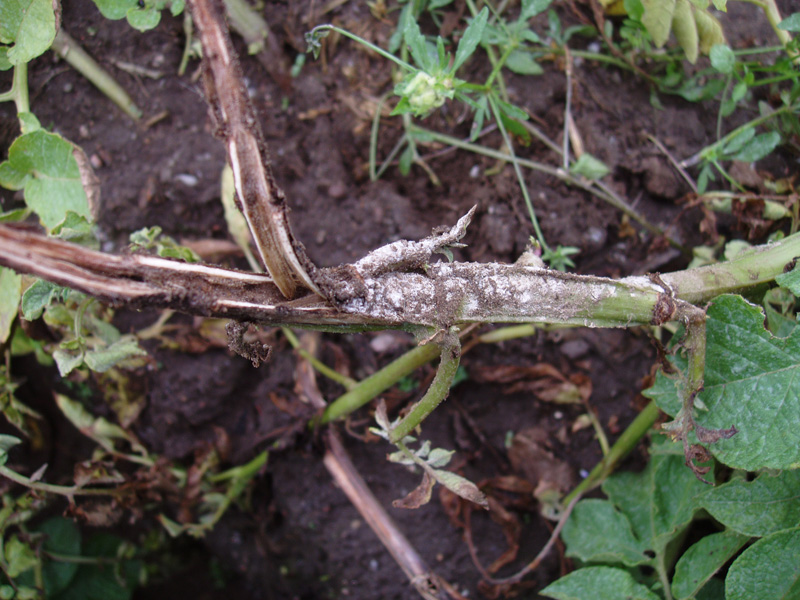
White Mold. Characteristic symptoms on the stems.
(Photo by J. Osowski)
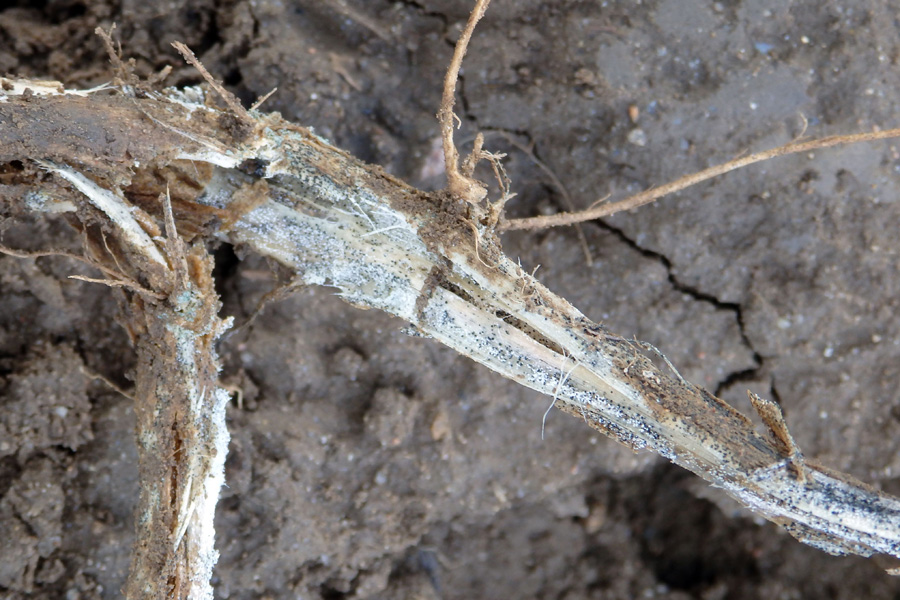
Potato Anthracnose. Microsclerotia characteristic of anthracnose.
(Photo by J. Osowski)
- Zaraza ziemniaka. Zarodnikowanie na łodydze (fot. J. Osowski)
- Zgnilizna twardzikowa. Przewężenia łodyg (fot. J. Osowski)
- Zgnilizna twardzikowa. Sklerocja spoczynkowe (fot. J. Osowski)
Characteristics and description of the disease
Sclerotinia Rot is a fungal disease occurring in various plants. The causative agent of the disease, the fungus Sclerotinia sclerotiorum, belongs to the group of ascomycetes. The pathogen is polyphagous, meaning it can affect numerous plant species, attacking over 400 different types, including vegetables, herbs, ornamental plants, and industrial crops. However, it causes the most significant losses among industrial plants, particularly in rapeseed and tobacco. The disease’s harmfulness is substantial, with rapeseed losses reaching up to 60% of the yield, as the pathogen can survive in the soil for 7-10 years or even longer. Plant damage, low resistance of varieties, and the presence of host plants contribute to the development of the pathogenic fungus. Crops located near coasts, in valleys, and areas with natural high air humidity are particularly vulnerable to Sclerotinia rot.
Previous information about Sclerotinia rot affecting potatoes primarily came from northern regions of the United States and Canada, India, and in Europe, only from the United Kingdom, Ireland, and the Netherlands. In recent years, symptoms of Sclerotinia rot have also been observed in potato fields in Poland, especially in plantations established after vegetable crops (e.g., carrots) or rapeseed.
The S. sclerotiorum fungus can overwinter in the form of mycelium in dead plant residues or living plants. However, it primarily survives as hard, black sclerotia in the soil. Sclerotinia Rot is a soil-borne disease. Sclerotia, responsible for primary infection, can remain in the soil for up to 8 years and, according to some sources, even up to 15 years. Infection of potato plants occurs in the spring. At temperatures of 10-12°C and high soil humidity, the fungus’s sclerotia germinate, infecting plants in two ways: sclerotia germinate directly into fungal mycelium, which starts to affect the lower parts of plants (stems, leaves) at the soil line, or sclerotia form apothecia – fruiting bodies that emerge above the soil surface. Apothecia produce ascospores, wind-dispersed spores that can infect both lower and upper parts of plants. Although the former method of pathogen spread occurs more frequently, the disease can develop through both pathways in Poland’s climatic conditions.
Large quantities of ascospores are released into the air over several weeks, peaking during the full flowering of potatoes. Ascospores accumulate on plants in stem branches, where pollen and falling flower petals gather, providing a favorable substrate for spore germination. Warm and humid weather until the potato flowering stage creates favorable conditions for infection. The fungus then colonizes subsequent plant tissues.
In areas with a high sclerotia content in the soil, Sclerotinia rot symptoms can appear in the field. Stem damage occurs after the plants close ranks in rows and during the flowering period. However, the most intense infections are observed in storage or cold rooms. In storage, sources of infection include not only affected plants but also leaf residues (e.g., infected haulms or soil containing sclerotia).
Symptoms of Infection:
Initial symptoms of Sclerotinia Rot are often observed on stems near leaf nodes (photo 1). They appear as water-soaked spots and later turn beige, often with a dark border. In the early stages of infection, no symptoms are observed on the leaves. Sometimes, stem constrictions develop at the infection site (photo 2). Further plant damage involves the longitudinal splitting of stems. Only after stem destruction (tissue delamination) do the leaves above the damage wilt and die. Inside the stem core, and in high humidity conditions, a white layer of more or less abundant mycelium appears (photo 3), containing initially white to gray, and later black and hard resting sclerotia, measuring 2 to 10 mm in length (photo 4). Their shape is highly irregular.
Symptoms of Sclerotinia Rot are often confused with symptoms of other stem diseases:
Anthracnose caused by the fungus Colletotrichum coccodes. In the case of anthracnose, initial symptoms on the above-ground parts of potatoes are not very characteristic. Stems remain green for a long time, then turn brown and eventually dry out. Affected stems show white fungal mycelium on the surface, less abundant and more compact (felt-like) than in the case of Sclerotinia Rot. Numerous small microsclerotia (sized 0.1-0.6 mm), characteristic of anthracnose, appear on the affected wood tissue. Late Blight (Phytophthora infestans) occurring on stems, where during high humidity, white mycelium can be observed on necrotic tissue. Rhizoctonia solani’s sexual stage, causing Rhizoctonia canker, occurring at the base of potato stems in moist conditions.
However, none of these diseases exhibit the longitudinal splitting of stems and the presence of large, black sclerotia, which are characteristic of Sclerotinia Rot.
Control Methods:
Controlling the disease is challenging due to the fungus’s broad range of host plants and persistent sclerotia, which can survive in the soil for several or even a dozen years. Disease development can be limited by meticulous crop rotation, deep plowing (reducing the number of apothecia forming on the soil surface), and proper rotation (growing non-host plants, such as grains and grasses, before potatoes).
Due to the pathogen’s dual development, chemical control is extremely difficult. Preparations that can be applied to control Sclerotinia Rot only eliminate this year’s disease symptoms, without reducing the pathogen’s infectivity in the soil. Additionally, the disease exhibits the highest development dynamics in storage, making it impossible to apply additional protective treatments due to the lack of registered agents. High effectiveness in controlling “current” disease symptoms during the growing season is achieved by using fungicides from full flowering (70-100% of flowers) to the beginning of petal fall. Among the fungicides registered for potato cultivation, fluazinam and boscalid showed the best results in controlling Sclerotinia Rot in American studies.
Compiled by: Prof. Dr. Hab. Józefa Kapsa

